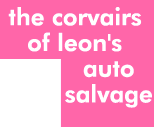

![]()
In business since 1961, Leon's Auto Salvage is a 105-acre, 10,000-car junkyard located in the heart of the Virginia Piedmont (within a 50 mile radius of the estates of presidents Jefferson, Madison, and Monroe). Frankly, Leon's is a sprawling, incomprehensible mess. If you love old cars as much as I do, Leon's can be the most depressing place on earth. Simply put, everything at Leons is rusty trash -- the cars get pushed around by bulldozers, and fellow parts scavengers often times neglect to close hoods and doors (if you frequent junkyards too, PLEASE close anything you open!). This is especially sad considering what lives at Leon's:
And, of course, there are many Corvairs (and that's what you came to see, right?):
A few words on the Spyder convertible: with no engine, dashboard, or trim, it was almost impossible to distinguish this '63 Spyder from a non-turbo Corvair. Two clues gave it away, however. The holes on the hood where the engine badge once went were at one o'clock and seven o'clock, thereby denoting that a "turbo-charged" emblem was once there. Secondly, despite the fact that the special Spyder dash was long gone, the housing for the windshield wiper controls was still in place -- on Spyders these controls were under (rather than on) the dash, in their own separate pod. This car was black, with a white top and (remnants of) a red interior. It must have been really breathtaking on the dealer lot all those years ago.
![]()